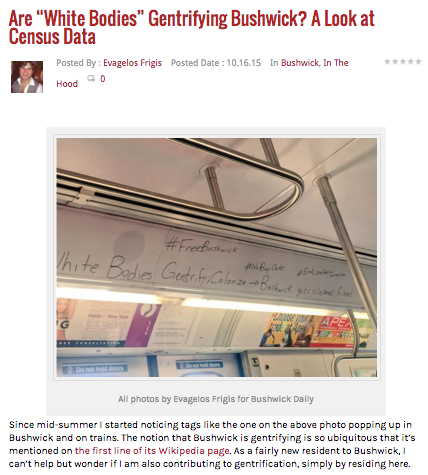
The only thing I really know about gentrification is that it is a very complex, multifaceted subject that triggers a lot of emotions, and not having those emotions clouding one’s judgment while in the middle of a heated discussion takes some serious Zen practice.
As the editor-in-chief and founder of Bushwick Daily, I won’t pretend that I have gentrification figured out—I don’t, and I dare to say that very few people do. And so whenever a writer approaches me with the intent to discuss an aspect of gentrification in writing, I am typically wary. I usually warn them that it is an incredibly complex and emotional subject, and chances are that they won’t get it right. I said the same thing to Evagelos Frigis, who approached me—with good intentions, I believe—wanting to write a piece that looked closely at the changes in Bushwick demographics according to the census data. Evagelos assured me that if somebody were to find evidence against his findings than it would be good news for everyone, simply because it would mean we’d all learn something. I liked this approach of openness to critique of one’s own writing, and even potential mistakes, and the notion of learning resonated with me as well. Furthermore, I am always in favor of well-researched articles that explain data, which may or may not contradict existing opinions rooted within public.
Evagelos’s piece titled “Are ‘White Bodies’ Gentrifying Bushwick? A Look at Census Data,” published on October 16, arrived at some interesting conclusions—particularly that the number of Latin residents of Bushwick had barely changed in 10 years and that the number had in fact mildly increased. Evagelos also concluded: “During such a volatile national atmosphere in the face of race and ethnic relations, my biggest worry is blame being placed on a single demographic for the woes caused by gentrification in Bushwick. It’s much easier to demonize a single ambiguous ‘them’ as the perpetrators, rather than criticizing the multifaceted dynamics that surround gentrification.”
The piece has naturally stirred quite a bit of discussion among our readers; the most pronounced criticism of the article points to the use of census data. The United States Census is decennial, and the latest available data is from April 1, 2010. As of today we don’t have data that reliably shows the changes in Bushwick’s demographics and, unfortunately, we will have to wait until 2020 to obtain it. A number of our readers, including myself, lived in Bushwick in 2010 and it is beyond doubt that Bushwick has changed since then. It feels as if those five years might as well have been traveled at the speed of light.
Therefore the findings obtained from the old set of data applied to today’s Bushwick can be more than problematic. Furthermore, the findings of the article may be understood as suggesting that the hardships of Bushwick natives in these tumultuous times of rapid gentrification aren’t real, but rather are only perceived. For this possible consequence of the article, I would like to apologize. I should have realized it as Evagelos’ editor before the article was published. The effects of gentrification on housing situations, particularly amongst low income Bushwick residents, have been very real. Many people have found themselves vulnerable—harassed by their landlords or evicted with no other option than seeking homeless shelters. This situation is particularly serious for families with small children and elderly. Bushwick Daily has been regularly covering the tribulations of the housing market, and I would like to stress that the Bushwick Daily contributors and I have nothing but compassion for and the strongest sense of solidarity with people who lost, or are at the verge of losing, their homes.
The article will remain on Bushwick Daily despite any mistaken conclusions drawn from the data used, and this note will be linked to in the beginning of the post. I will not take it down because I believe that the discussion sparked by it has been valuable; without the original source it would lose its meaning for future reference.
Of the many responses we have received since running the article, I would like to specifically acknowledge a response written by Bushwick-born artist and activist Anthony Rosado, which he published on his personal website as well as on the Bushwick Community Map blog. Anthony approached me with a request to publish his response here on Bushwick Daily, and I decided not to do so. From an editorial standpoint, it made little sense to re-publish an article that was not an original piece of writing and that had appeared on other websites already. Anthony also requested that I publish the piece as is, without any edits whatsoever. This is not standard editorial practice and I didn’t feel comfortable publishing a piece of writing that, in my opinion, was problematic in several parts. However, Anthony makes several valid points and I encourage you to read it.
As always, we welcome submissions from the community, especially from the voices of Bushwick natives, that promote mutual understanding and community building. Please use this online form to pitch your ideas.
Thank you all for your understanding.


